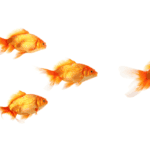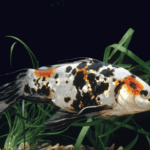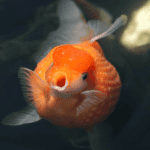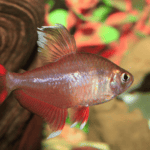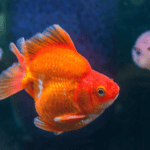Wakin Goldfish, originating from China, are known for their unique appearance and hardy nature. They possess an elongated body and a beautiful double tail, making them an attractive choice for both aquarium and pond enthusiasts. These fish come in a variety of colors, including red, white, and calico, which add vibrancy and interest to any aquatic environment.
These lively and active swimmers are not only popular for their aesthetic appeal but also for their relatively long lifespan. Wakin goldfish can live for 10 to 15 years, and even up to 20 years under optimal conditions. Hardy by nature, they thrive in a temperature range of 60-78ºF but can also tolerate colder pond temperatures during winter months.
Wakin goldfish are herbivores and have a propensity for uprooting plants in their environment. Thus, for those looking to create a visually appealing and well-maintained habitat, it is recommended to use plastic plants and additional elements like rocks and sticks for enrichment. These charming and energetic fish will undoubtedly make a fascinating addition to any home aquarium or outdoor pond.
Wakin Goldfish Origins
The Wakin goldfish, known scientifically as Carassius auratus, is an intermediate twin-tailed goldfish variety that originated in Japan. This captivating goldfish is believed to have given rise to many fancy twin-tailed goldfish varieties, such as the ryukin, ranchu, oranda, fantail pearlscale, and more.
These goldfish were developed from the common goldfish and have a rich history dating back to the early 16th century. During their initial days, Wakin goldfish were highly prized and considered a symbol of wealth and affluence, making them accessible only to the wealthy in Japanese society.
Some key factors that distinguish Wakin goldfish from other goldfish varieties include:
- Their hardy nature, allowing them to withstand varying temperature ranges (60-78ºF) and pond conditions, which makes them ideal for both indoor aquariums and outdoor ponds.
- A typical lifespan of 10-15 years, sometimes even up to 20 years in larger ponds with optimal conditions, making them one of the most long-lived goldfish varieties.
- Their unique twin-tail and elongated, slender body structure that sets them apart from other fancy goldfish, combining aspects of both single and double-tailed goldfish varieties.
In summary, Wakin goldfish have a storied origin, dating back to 16th-century Japan. Their unique features, adaptability, and long lifespan make them a fascinating and cherished goldfish variety within the broader Carassius auratus family.
Physical Characteristics
Color Varieties
Wakin goldfish are known for their striking color patterns, which mainly include:
- Red
- Red and white
- Calico (red, white, and black)
These colorful combinations make the wakin goldfish visually appealing and a popular choice for aquarium enthusiasts.
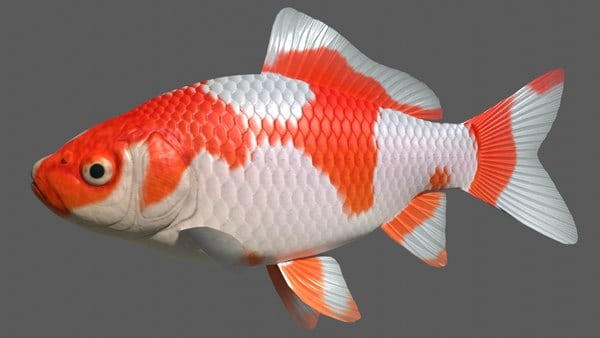
Size and Shape
The wakin goldfish has an elongated body, similar to that of a common goldfish. They can grow up to 10 inches in length, although their size may vary depending on the environment and care they receive.
Fins and Tail
The most distinguishing feature of the wakin goldfish is its double tail, which fans out gracefully from its caudal fin. In addition to the double tail, the wakin goldfish has a dorsal fin, giving it an elegant appearance as it swims through the water. The combination of the elongated body, vibrant colors, and unique fins make the wakin goldfish a beautiful addition to any aquarium or pond setting.
Behavior and Temperament
Wakin Goldfish are known for their social, gentle, and friendly nature. They make great pets due to their peaceful and curious disposition. These charming fish enjoy exploring their environment, investigating plants, substrate, and other items in the tank while also taking an interest in the people around them.
In terms of activity, Wakin Goldfish have streamlined bodies, which allow them to be fast-moving swimmers. Their slender shape and agility make them stand out among other types of goldfish, especially those with more rounded bodies.
The behavior of Wakin Goldfish can be described as:
- Social: They usually thrive in small groups, bonding with their tank mates and displaying peaceful interactions.
- Gentle: Wakin Goldfish do not tend to display aggressive behavior towards other fish or tank mates.
- Curious: They will often explore their environment by perusing every nook and cranny of their tank, showcasing their inquisitive nature.
As for their temperament, the typical Wakin Goldfish is:
- Friendly: They will often approach people near the tank, inviting interaction and creating a sense of connection with their human caretakers.
- Peaceful: With little to no aggression displayed among Wakin Goldfish, they maintain a harmonious environment within community tanks.
- Adaptable: These fish can adjust easily to new surroundings, making them suitable for both home aquariums and outdoor ponds.
When setting up a comfortable habitat for Wakin Goldfish, it is crucial to consider the water conditions. They thrive in cool water with temperatures between 65°F and 78°F, a pH level of 6.0 to 8.0, and water hardness of 5 to 19 dGH. Ammonia and nitrite levels should always be zero, with nitrate levels ideally below 20 ppm.
By understanding the behavior and temperament of Wakin Goldfish, hobbyists can ensure a pleasant environment and help maintain the health and happiness of these delightful aquatic pets.
Wakin Goldfish Habitat
Indoor Aquarium Setup
Wakin Goldfish are freshwater dwellers and can be kept in indoor aquariums. A minimum tank size of 20 gallons is suggested for a single Wakin goldfish with an additional 10 gallons for each additional fish.
It’s essential to provide a powerful filtration system as goldfish produce a significant amount of waste. Maintaining clean water through weekly 30% partial water changes is crucial for the goldfish’s health. The recommended water temperature should be between 60-78ºF.
For the substrate, you can use either sand or fine gravel. When decorating the aquarium, provide plenty of swimming space and consider adding live plants to help absorb nitrates. However, avoid using plants with delicate leaves, as goldfish tend to nibble on them. Use decorations like driftwood or rocks to create hiding spots, but ensure they don’t have sharp edges that might injure the goldfish.
Outdoor Pond Environment
Wakin Goldfish also thrive in outdoor ponds and water gardens, providing room for them to grow and explore. A pond size of at least 1000 gallons is ideal to support a group of these goldfish. Make sure there’s a good balance between open swimming spaces and sheltered areas, utilizing pond plants like water lilies or lotus.
The pond should have a depth of at least 3 feet to provide stable water temperatures and protect the fish from predators. Additionally, a quality pond filter and aeration system are necessary to maintain water quality and oxygen levels.
To set up a suitable habitat for Wakin goldfish in an outdoor pond, consider the following:
- Install a pond liner to help retain water and minimize leakage
- Integrate a pond skimmer to remove debris and maintain water clarity
- Add a mixture of submerged, floating, and marginal plants for shelter and oxygen production
- Provide smooth rocks or other hiding spots for goldfish to rest or escape predators
In summary, Wakin Goldfish can thrive in both indoor aquariums and outdoor ponds. Proper habitat setup, along with maintaining water quality, is essential for their health and longevity.
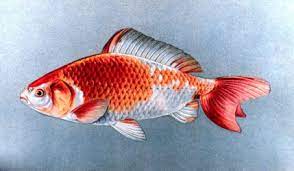
Tank Requirements
Tank Size
Wakin goldfish are active fish and require a spacious tank to accommodate their movement. It is recommended to have a tank of at least 30 gallons for one Wakin goldfish, and add an additional 10 gallons for each fish you plan to introduce to the tank. This allows them enough space to move around comfortably and spend time in different areas throughout the day.
Filtration System
A proper filtration system is essential for maintaining a healthy environment for your Wakin goldfish. Choose a filter capable of handling the tank’s size and ensure it provides mechanical, biological, and chemical filtration. Since Wakin goldfish produce a lot of waste, it is crucial to have an efficient filtration system in place to break down and remove the waste, keeping the water clean and healthy for your fish.
Lighting
Wakin goldfish do not require any special lighting. However, providing a consistent light cycle with 8-10 hours of light per day will help regulate their natural biological processes. You can use standard aquarium lights, such as LED or fluorescent lights, which also help create a balanced environment for live plants if you choose to include them in your tank setup. Remember to turn off the lights at night to mimic a natural day and night rhythm for your fish.
Temperature
The ideal water temperature for Wakin goldfish ranges between 65-78 degrees Fahrenheit. To maintain this temperature, it may be necessary to use an aquarium heater, especially if the room temperature in which the tank is placed fluctuates throughout the year. Regularly monitor the water temperature and adjust the heater settings accordingly to keep the conditions suitable for your Wakin goldfish.
Diet and Feeding
Wakin goldfish are omnivorous, which means they eat both plants and meat. This gives them a wide variety of food sources to choose from. Their diet should include a mix of both, with a strong focus on providing a balanced and nutritious meal plan.
A high-quality diet is essential for wakin goldfish, as it contributes to their overall health, longevity, and vibrancy. You can start by offering them a staple diet of goldfish pellets, specifically designed for them, which contain the essential nutrients they require.
To add variety, include live or frozen foods in their diet, such as:
- Brine shrimp
- Daphnia
- Bloodworms
- Blackworms
- Tubifex worms
However, it is essential to keep in mind the size of the wakin goldfish when offering these food sources. Smaller fish should be fed smaller-sized live or frozen foods to avoid choking hazards.
In addition to meaty foods, wakin goldfish also require plant-based foods. Some plant-based options to consider are:
- Spirulina flakes
- Blanched vegetables (such as peas, spinach, and lettuce)
- Sliced and boiled zucchini
- Small amounts of aquatic plants (such as duckweed and Anubias)
Feed your wakin goldfish 2-3 times a day, offering only small amounts that can be consumed within 2-3 minutes. Overfeeding can lead to poor water quality and health problems.
A well-rounded diet, combined with proper care, will ensure that your wakin goldfish remains healthy and reaches its full potential size, which can range from 8 to 12 inches long.
Wakin Goldfish Compatibility
Wakin Goldfish are a beautiful and hardy breed known for their elongated bodies and double-tail fins. In terms of compatibility, they can coexist harmoniously with various other fish species, especially those in the Cyprinidae family.
Some ideal tank mates for Wakin Goldfish include fellow goldfish varieties, such as the Common Goldfish, SHubunkin, and Comet. These goldfish breeds share similar water condition preferences and social temperaments. However, it is crucial to ensure that the tank or pond has enough space to accommodate all the fish comfortably.
When selecting compatible tank mates, it’s essential to consider the following factors:
- Size: Choose species of a similar size to reduce the risk of aggression or competition for resources.
- Temperament: Opt for non-aggressive or peaceful fish, as Wakin Goldfish are social and enjoy a serene environment.
- Water Conditions: Ensure all species thrive under the same water temperature, pH level, and hardness.
Wakin Goldfish prefer cooler water temperatures, typically between 65º and 78º Fahrenheit, a pH between 6.0 and 8.0, and water hardness of 5 to 19 dGH.
It’s important to avoid housing Wakin Goldfish with tropical fish, as they generally need warmer water temperatures. Moreover, don’t pair your Wakin Goldfish with fish that are too large or have a history of aggression, as this may result in stressed or injured goldfish.
In conclusion, Wakin Goldfish are compatible with a range of other goldfish varieties that share similar living requirements and temperaments. Ensuring that the fish coexist peacefully in a spacious environment will contribute to their overall health and longevity.
Breeding Wakin Goldfish
Breeding Wakin Goldfish can be a rewarding experience when given the appropriate living conditions and a high-quality diet. These hardy fish have distinctive physical traits, including an elongated body and a beautiful double tail.
Wakin Goldfish naturally mate when the water temperature resembles springtime conditions. It is crucial to achieving an ideal water temperature of around 65 degrees Fahrenheit in your aquarium to encourage mating between male and female Wakins. In addition to the water temperature, providing a spacious environment and maintaining good water quality also play a significant role in successful breeding.
Sexing young Wakin Goldfish can be challenging since males and females may look similar. However, as they mature, their differences become more apparent:
- Females: Generally plumper and rounder than males, with a slightly larger abdomen.
- Males: Develop white tubercles on their gill covers and pectoral fins during the breeding season. This characteristic is referred to as peduncle flash.
When it comes to breeding, it’s important to consider the following factors:
- Environmental Setup: Make sure to provide suitable breeding grounds, such as submerged and floating plants, to mimic the natural habitat of Wakin Goldfish. These plants also serve as egg attachment sites.
- Feeding: Supply a balanced and nutritious diet consisting of high-quality pellets, flakes, and live or frozen foods like brine shrimp, daphnia, and bloodworms. Proper nutrition ensures a higher success rate during the breeding process.
- Spawning Process: During spawning, the male will chase the female, often nudging her at the peduncle area. This process may last for several hours, with the female laying numerous adhesive eggs (up to several thousand) on plants or other surfaces.
- Egg Care: Once the eggs have been laid, it is advisable to remove adult fish from the breeding tank to prevent them from eating the eggs. Eggs will hatch within 2-7 days, depending on temperature and water quality.
In conclusion, breeding Wakin Goldfish requires attention and care, but with proper preparation, ideal living conditions, and patience, successful breeding can be achieved.
Wakin Goldfish Lifespan and Health
Wakin Goldfish, which are a hardy breed, typically have a lifespan of between 10 and 15 years. However, they can live longer if provided with a high-quality diet and ideal living conditions. Their attractive double tail, vivid color, and friendly, curious temperament have made them a popular choice among goldfish enthusiasts.
To ensure the health and longevity of your Wakin Goldfish, it is important to maintain good water quality. They are freshwater fish that can adapt to both hard and soft water. The ideal pH levels for Wakin Goldfish are between 6.0 and 8.0.
These goldfish thrive in colder waters, and it is essential to maintain a water temperature below 75° F. Higher temperatures can negatively affect their health.
Some key aspects of maintaining water quality for Wakin Goldfish include:
- Regular water changes: Replace a portion of the water in the tank or pond every week to maintain cleanliness and balance.
- Filtration: A good quality filter will help keep the water clean and free of harmful toxins.
- Monitoring: Regularly testing the water’s pH level and temperature will ensure a consistently healthy environment.
In addition to providing a clean and safe water environment, it is also important to offer a balanced diet to maintain your Wakin Goldfish’s health. An appropriate diet can consist of quality flakes or pellets, as well as occasional treats such as brine shrimp, daphnia, and bloodworms.
Remember, the key to your Wakin Goldfish’s health and longer lifespan lies in its living conditions and care. So, provide them with clean water, monitor the pH levels and temperature, and offer a nutrient-rich diet to keep your fish happy and healthy for years to come.
Additional Considerations
When maintaining a healthy environment for Wakin goldfish, it’s essential to consider some additional factors, such as plants, tank set-up, and color forms.
Wakin goldfish are known for their double-tail feature, and just like other pond fish, they enjoy a well-planted environment. Here is a list of suitable plants that can be included in their tank or pond:
- Anacharis
- Hornwort
- Java fern
- Vallisneria
- Water lettuce
Make sure to provide enough hiding spots for the fish using plants and other tank decorations.
When setting up the tank for Wakin goldfish, ensure you have a suitable filtration system, as they produce a lot of waste. A high-quality external or internal filter can help maintain perfect water quality. Additionally, bear in mind the following:
- Tank Size: A minimum of 20-30 gallons per fish is recommended
- Water Temperature: 65°F to 78°F
- pH level: 6.0 to 8.0
- Water Hardness: Between 5 and 19 dGH
Wakin goldfish come in various color forms, including red, red, and white, or calico (red, white, and black). In case you plan on hosting different colors in the same tank or pond, maintain water quality consistently for all the fish to thrive.
In conclusion, Wakin goldfish are hardy and active fish that make wonderful additions to any pond or tank. Just pay attention to their specific requirements for tank set-up, compatible plants, and water parameters to ensure these beautiful double-tailed fish thrive.
